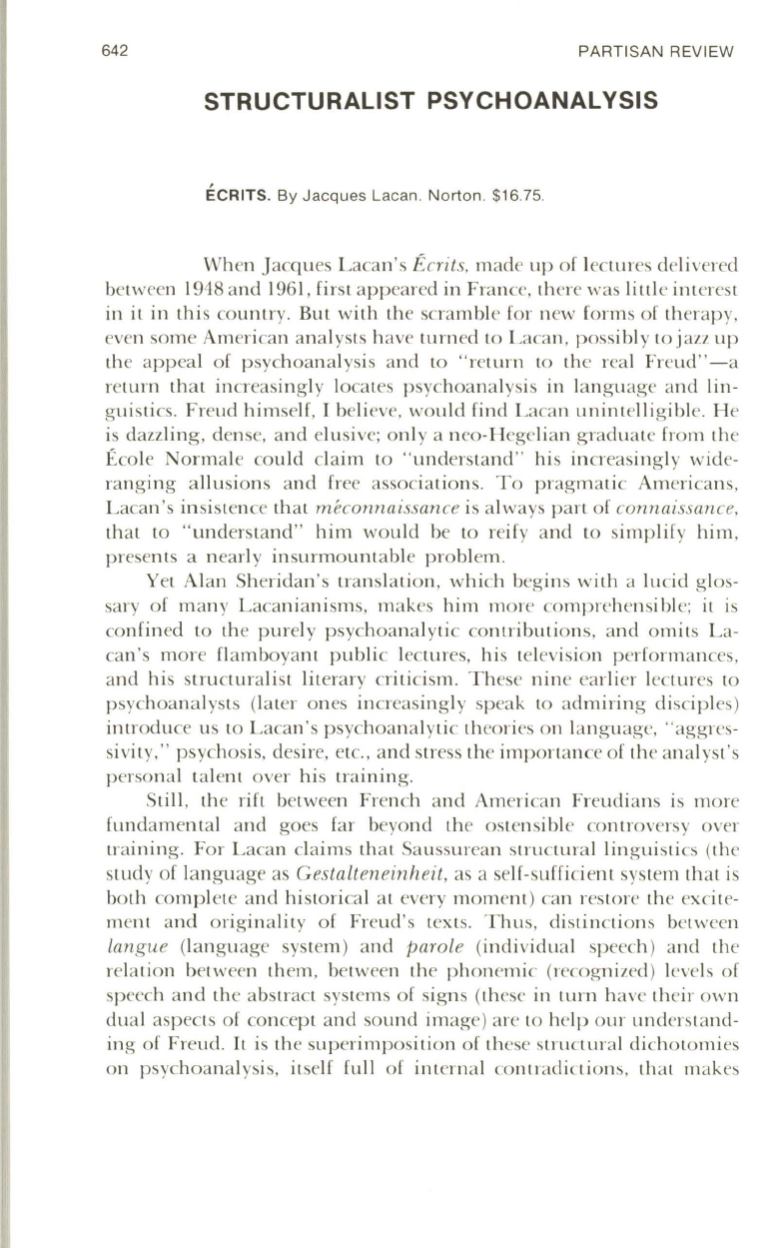
642
PARTISAN REVIEW
STRUCTURALIST PSYCHOANALYSIS
ECRITS.
By
Jacques Lacan . Norton.
$16.75.
When Jacques Laca n 's
Ecri ts,
made u p of lectures deli vered
between 1948 and 1961 , first appea red in France, there was lilli e interes t
in it in this country. But with the scrambl e fo r new fo rms o f therapy,
even some Ameri can analysts have turned to Lacan , possibly to jazz up
the appeal o f psychoana lysis and to "return to the rea l Freud " - a
return th a t increas ing ly loca tes psychoana lys is in la nguage and lin–
gui sti cs. Freud himself, I beli eve, would find Laca n unintelli gibl e. He
is dazzling, den se, and elusive; o nl y a n eo-Hegeli an g radua te from th e
Eco le Normale could cl aim to " understand " hi s increas in gly wide–
rang ing allu sions and free associa tion s. T o pragmati c Ameri can s,
Lacan 's in sistence th a t
m econnaissance
is a lways pa rt of
connaissance,
tha t
to
" understand" him would be to reify and to simplify him,
p resents a nearl y in surmountabl e problem .
Yet Al an Sheridan 's tran sla ti on , which beg in s with a lucid glos–
sary of m an y Lacani ani sms, makes him ma rc comprehensibl e; it is
confined to the purely psychoana lyti c contributi ons, and omit s La–
can' s mo re fl amboyant publi c lectures, hi s televi sio n perfo rmances,
and his structurali st litera ry cr iticism . These nin e earli er lectures to
psychoana lys ts (l a ter ones in creas ing ly spea k to admirin g di sc ip les )
introduce us to Lacan 's p sychoana lyti c theori es a ll la nguage , "aggres–
sivity," psychosi s, desire, etc., and stress the impo rtance of th e ana lys t's
persona l ta lent over hi s tra inin g .
Still , th e rift between French and Ameri can Freudi ans is mo re
fund amenta l and goes far beyond the os tensibl e controversy over
tra ining. Fo r Laca n cla ims tha t Sa ussurean structura l lin gui sti cs (the
study of language as
Gestalteneinheit ,
as a se lf-suffi cient system tha t is
bo th compl ete and histori ca l a t every moment ) can resto re the excite–
ment and o ri gin a lity o f Freud 's texts. Thus, di stincti ons between
langue
(l anguage sys tem ) and
parole
(individua l speech ) and the
rela ti on between th em , between the phonemi c (recogni zed ) levels o f
speech and the abstract sys tems o f signs (these in turn have th eir own
dua l aspects of concept and sound image) a re to help o ur understand–
ing of Freud.
It
is th e superimpos ition of these structura l di cho tomi es
on psychoana lys is, itself full o f interna l contradi cti on s, tha t makes


